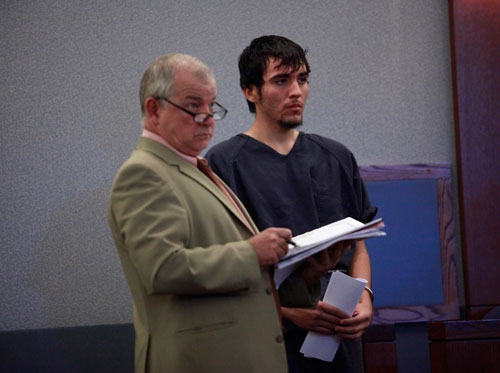Murder suspect served time in juvenile facility for Centennial assault

The girl did not know the tall boy with jet-black hair.
He might not have known her, either. Centennial High School is a big place.
But he wasn’t interested in a formal introduction.
As the 16-year-old girl disappeared into a school bathroom, the boy followed. And when she tried to exit her stall, he pounced.
She screamed as the boy’s hands clamped around her throat. He forced her back into the stall and jammed her against the toilet.
It’s unclear how long the assault in 2009 lasted. It ended after another student heard screams and followed the sound into the bathroom.
That student was the person who later identified the boy to Clark County School District police: Javier Righetti, then 17, and now charged with murder in the brutal rape and killing of 15-year-old Alyssa Otremba over Labor Day weekend.
Because Righetti was a minor, the juvenile court sealed the case. The Review-Journal learned about the Centennial incident through multiple sources with knowledge of the offense.
Experts now say the attack may have been the first documented incident in a pattern of behavior pointing to a budding serial killer.
Righetti, now 19, was expelled from Centennial, in the northwest valley, after the 2009 assault. He was charged with felony kidnapping, coercion and battery, according to sources. He was sentenced to one year at the Caliente Youth Center, a secure facility.
What troubled investigators — at the time of the Centennial assault and again after Otremba’s death — was that Righetti was not charged with a sex offense in the bathroom attack.
Because of that, he probably wasn’t treated as a potential sex offender while incarcerated, said Alexis Kennedy, a criminal justice professor at UNLV and an expert in youth sex offenses.
"If he wasn’t charged with anything sexually related, they probably wouldn’t have done a sex offender assessment," Kennedy said. "It wouldn’t have been on their radar."
Rehabilitation is the primary goal of juvenile justice, Kennedy said. But how do you fix a sex offender if you don’t know he’s a sex offender?
Katherine Ramsland, a criminal justice professor at DeSales University in Pennsylvania and an expert on serial killers, said courts are hesitant to label juveniles.
Although authorities may have suspected Righetti was a potential sex offender, labeling him as one in 2009 would have been premature without additional evidence.
"No matter what their opinions were, if you overreach and label a kid as a sex offender, that could be detrimental for life," she said. "But this kid has shown, he was on his way."
Attempts to reach Righetti’s family members were unsuccessful. Deputy Public Defender Tim O’Brien, who represents Righetti, declined to comment.
The similarities between the 2009 assault and Otremba’s killing were striking.
In both cases, Righetti was accused of approaching a girl whom he did not know in a busy area. In the first case, it was at school; in the second, a well-lit, heavily traveled street.
In both cases, the motivation was sexual, sources said. But in the Centennial incident, there was no physical proof of a sexual assault.
"He just didn’t have time to do anything to her. This guy was a sick puppy," said one source, who requested anonymity.
Otremba was not as fortunate.
The Arbor View High School freshman was raped before being stabbed more than 40 times, Las Vegas police said. Her body was then doused with gasoline and set ablaze.
Righetti confessed to police, according to his arrest report. In the interview with detectives, Righetti also admitted to another rape and robbery. Detectives are investigating those claims as Righetti awaits his fate in the Clark County jail.
One law enforcement source called Righetti a "monster" who was already a serial rapist with a growing compulsion to kill.
Ramsland agreed, assessing that the suspect fits the profile of a budding serial killer.
"He’s got the anger issues, he uses weapons, he has brutalized people, he takes risk, and he’s starting young," she said. "Those are all pretty big red flags."
In both incidents, authorities said Righetti attacked girls despite a high probability of being caught.
That’s an impulse act, as opposed to a calculated plan, Ramsland said.
"The opportunity was there, and he had the compulsion to act," she said. "The driving need usually comes from a rich fantasy life where he (a serial killer) does things like that. When he sees an opportunity to actually do it, he may act.
"Only after the feelings recede does he realize the risk he took," she said.
Kennedy said it’s natural to cast blame toward authorities after a heinous event, but predicting behavior in teenagers is an imprecise science.
"Human behavior is so hard to predict," she said. "This was the worst possible outcome of the worst possible scenario."
Because juvenile records are sealed, the public doesn’t know exactly how Righetti’s case was handled.
Kennedy said the "choking" aspect of the Centennial incident should have concerned authorities. That’s a sign of escalating violent tendencies, she said.
Could Otremba’s death have been prevented? No one can know, Kennedy said. Even in the best-case scenario, with all the right treatment and therapy, Kennedy said sex offenders may relapse.
"Everyone in corrections at juvenile justice is saying, ‘I hope I haven’t had this person,’ " Kennedy said.
"Every system that had contact with him is second-guessing themselves, looking at what they might have done differently."
Contact reporter Mike Blasky at mblasky@reviewjournal.com or 702-383-0283.